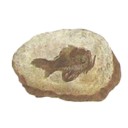
|
Designating a lectotype for Mesacanthus pusillus (Gnathostomata: Acanthodii)
Keywords:
acanthodians; Chordata; Devonian; Midland Valley; Orcadian Basin
doi: 10.18563/pv.44.1.e2
Cite this article:
Baron M., Seymour K., 2021. Designating a lectotype for Mesacanthus pusillus (Gnathostomata: Acanthodii). Palaeovertebrata 44 (1)-e2. doi: 10.18563/pv.44.1.e2
Export citation
Abstract
The early gnathostome genus Mesacanthus is well represented in both Lower Old Red Sandstone and Middle Old Red Sandstone assemblages of northern and central Scotland. This ‘acanthodian’ taxon is currently thought to comprise two valid species: M. mitchelli and M. pusillus. Although the whereabouts of the holotype of M. mitchelli (NHMUK PV P560) is known, the syntype material for M. pusillus has long been thought lost. Here we identify at least one specimen that formed part of the original syntype material for M. pusillus, albeit in a slightly different condition than when it was originally figured. This specimen is ROM 25872, which is here designated as the lectotype. A second specimen – ELGNM 1978.191.1 – could represent another of the syntype specimens, but poor preservation quality makes it impossible to be certain.
Published in 44-1 (2021)
Bibliography
Agassiz, J.L.R. 1833–1843. Recherches sur les Poissons fossiles. A Neuchâtel: Imprimerie Petitpierre. vol. 5, 1420 p.
Agassiz, J.L.R. 1844–1845. Monographie des poisons fossiles du Vieux Grès Rouge ou système Dévonien (Old Red Sandstone) des îles britanniques et de Russie. Jent et Grassmann, Neuchâtel. folio., 171 p. https://doi.org/10.5962/bhl.title.5752
Andrews, S.M. 1982. The discovery of fossil fishes in Scotland up to 1845 with checklists of Agassiz’s figured specimens. Royal Scottish Museum, Edinburgh. 87 p.
Baron, M.G. 2015. An investigation of the genus Mesacanthus (Chordata: Acanthodii) from the Orcadian Basin and Midland Valley areas of Northern and Central Scotland using traditional morphometrics. PeerJ 3, e1331. https://doi.org/10.7717/peerj.1331
Brazeau, M.D. and Friedman M. 2015. The origin and early phylogenetic history of jawed vertebrates. Nature 520, 490-497. https://doi.org/10.1038/nature14438
Burrow, C.J., Newman, M. J., Davidson, R. G. and den Blaauwen, J. L. 2011. Sclerotic plates or circumorbital bones in early jawed fishes? Palaeontology 54, 207-214. https://doi.org/10.1111/j.1475-4983.2010.01003.x
Burrow, C., den Blaauwen, J., Newman, M., and Davidson, R. 2016. The diplacanthid fishes (Acanthodii, Diplacanthiformes, Diplacanthidae) from the Middle Devonian of Scotland. Palaeontologia Electronica 19(1). 19.1.10A, 1-83. https://doi.org/10.26879/601
Burrow, C.J., Newman, M.J., and den Blaauwen, J.L. 2020a. First evidence of a functional spiracle in stem chondrichthyan acanthodians, with the oldest known elastic cartilage. Journal of Anatomy 236(6), 1154-1159. https://doi.org/10.26879/601
Burrow, C., den Blaauwen, J., and Newman, M. 2020b. A redescription of the three longest-known species of the acanthodian Cheiracanthus from the Middle Devonian of Scotland. Palaeontologia Electronica 23(1), a15.
den Blaauwen, J.L., Newman, M.J., and Burrow, C.J. 2019. A new cheiracanthid acanthodian from the Middle Devonian (Givetian) Orcadian Basin of Scotland and its biostratigraphic and biogeographical significance. Scottish Journal of Geology 55(2), 166-177. https://doi.org/10.1144/sjg2018-023
Denison, R.H. 1979. Acanthodii. In: Handbook of palaeoichthyology. Stuttgart: Gustaf Fischer Verlag. vol. 5.
Dupret, V., Sanchez, S., Goujet, D., Tafforeau, P., and Ahlberg, P. E. 2014. A primitive placoderm sheds light on the origin of the jawed vertebrate face. Nature 507, 500-503. https://doi.org/10.1038/nature12980
Egerton, P.M.G. 1861. British fossils. Memoirs of the Geological Survey of the United Kingdom (British Organic Remains) Decade 10, 51-75.
Giles, S., Friedman, M., and Brazeau M. D. 2015. Osteichthyan-like cranial conditions in an Early Devonian stem gnathostome. Nature 520, 82-85. https://doi.org/10.1038/nature14065
Newman, M.J. and Trewin, N.H. 2008. Discovery of the arthrodire genus Actinolepis (class Placodermi) in the Middle Devonian of Scotland. Scottish Journal of Geology 44(1), 83-88. https://doi.org/10.1144/sjg44010083
Newman, M.J. and Dean, M.T. 2005. A biostratigraphical framework for geological correlation of the Middle Devonian strata in the Moray-Ness Basin Project area. British Geological Survey Internal Report IR/05/160.
Newman, M.J., Burrow, C.J., and Blaauwen, J.L. den 2019. The Givetian vertebrate fauna from the Fiskekløfta Member (Mimerdalen Subgroup), Svalbard. Part I. Stratigraphic and faunal review. Part II. Acanthodii. Norwegian Journal of Geology 99(1), 1-16. https://doi.org/10.17850/njg99-1-01
Traquair, R.H. 1888. Old Red Sandstone fishes. Geological Magazine 5(3), 507-517. https://doi.org/10.1017/S0016756800182809
Trewin, N.H., Davidson, R.G. 1995. An Early Devonian lake and its associated biota in the Midland Valley of Scotland. Transactions of the Royal Society of Edinburgh: Earth Sciences 86(04), 233-246. https://doi.org/10.1017/S0263593300007641
Trewin, N.H., Davidson, R.G. 1999. Lake-level changes, sedimentation and faunas in a Middle Devonian basin-margin fish bed. Journal of the Geological Society 156(3), 535-548. https://doi.org/10.1144/gsjgs.156.3.0535
Zhu, M., Yu, X., Ahlberg, P. E., Choo, B., Lu, J., Qiao, T., Qu, Q., Zhao, W., Jia, L., Blom, H., and Zhu, Y. 2013. A Silurian placoderm with osteichthyan-like marginal jaw bones. Nature 502, 188-193. https://doi.org/10.1038/nature12617
|
PDF |
S.I. Data |
